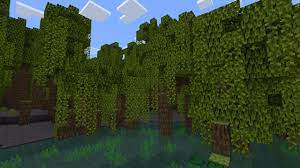Welcome to the green thumb guide on how to grow mangrove trees in Minecraft! If you’re looking to add a touch of tropical beauty to your virtual world, mangrove trees are the perfect choice. These unique trees not only enhance the aesthetic appeal of your Minecraft landscape, but they also offer a range of useful resources.
From their distinct appearance to their ability to thrive in aquatic environments, mangroves bring a refreshing element to your gameplay. In this guide, we will show you how to find and obtain mangrove saplings, create the ideal growing environment, plant and nurture your mangrove trees, and harvest their valuable resources.
So, grab your shovel and let’s dive into the world of mangroves in Minecraft!
Key Takeaways
- Mangrove trees enhance the aesthetic appeal of Minecraft and offer useful resources.
- They are found in swamp biomes and have thick trunks with exposed roots.
- Mangrove trees filter water, prevent erosion, and provide habitat for wildlife.
- To grow mangrove trees, find a suitable swamp biome, plant saplings in water, create an ideal growing environment, water regularly, and ensure plenty of light.
Understanding Mangrove Trees in Minecraft
To truly understand the intricacies of mangrove trees in Minecraft, you’ll need to immerse yourself in their unique characteristics and environmental significance.
Mangrove trees are found in swamp biomes and are easily recognizable by their distinctive appearance. They have thick trunks with exposed roots that extend downward into the water, providing stability and support.
These trees play a crucial role in the Minecraft ecosystem as they help filter water and prevent erosion. They are also home to a variety of wildlife, including fish and birds.
To grow mangrove trees in Minecraft, you’ll need to find a suitable swamp biome and plant the sapling in water. With proper care and patience, you’ll soon have a lush and vibrant mangrove forest in your Minecraft world.
Finding and Obtaining Mangrove Saplings
When searching for mangrove saplings, you can explore various biomes near bodies of water in order to increase your chances of finding them. Mangrove trees can be found in swamp biomes, which are characterized by their murky water and tall, thin trees.
These biomes often border oceans or rivers, so make sure to check these areas as well. Once you locate a swamp biome, keep an eye out for the distinctive mangrove trees with their unique root structures.
To obtain the saplings, you can either break the leaves of a mature mangrove tree or find them in chests in shipwrecks or underwater ruins. Remember to collect several saplings to ensure a successful mangrove tree plantation in your Minecraft world.
Creating the Ideal Growing Environment
Picture yourself in a lush, thriving habitat where the air’s filled with moisture and the soil’s rich with nutrients – this is the ideal growing environment you want to create for your mangrove saplings.
Start by selecting a suitable location for your mangrove trees. Look for a spot near water, like a river or an ocean, as mangroves thrive in brackish or saltwater environments. The soil should be sandy or muddy, as these types of soil retain moisture well.
Once you’ve found the perfect location, dig a hole that’s about twice the size of the mangrove sapling’s root ball. Place the sapling in the hole and backfill it with the soil, making sure to pack it firmly around the roots.
Water the sapling regularly, keeping the soil consistently moist. With the right growing environment, your mangrove saplings’ll flourish and contribute to the beauty and biodiversity of your Minecraft world.
Planting and Nurturing Mangrove Trees
Imagine yourself surrounded by flourishing mangrove saplings, each one planted with care and nurtured to create a thriving ecosystem in your Minecraft world.
To begin, gather mangrove saplings from the swamp biome, as they can only be found there.
Next, choose a suitable location near water, as these trees require a constant source of moisture.
Dig a hole one block deep and place the sapling in the center. Make sure there is enough space around the sapling for it to grow.
After planting, water the sapling with a bucket of water to help it grow faster.
Keep in mind that mangrove trees need plenty of light, so avoid planting them in shaded areas.
With proper care and attention, your mangrove trees will grow tall and strong, adding beauty and diversity to your Minecraft world.
Harvesting and Utilizing Mangrove Resources
To fully embrace the potential of your lush mangrove forest, you can carefully harvest and utilize the abundant resources that these unique trees offer in your Minecraft world.
Once your mangrove trees have matured, you can harvest their logs by using an axe. These logs can be used as a building material or to create useful items such as fences, doors, or even boats.
Additionally, you can collect the saplings that drop from the trees and use them to expand your mangrove forest or to plant in other areas.
Another valuable resource that mangrove trees provide is their leaves. By using shears, you can gather these leaves and use them for decorative purposes or as a fuel source in furnaces.
With proper harvesting and utilization of mangrove resources, your Minecraft world will flourish with the beauty and functionality of these incredible trees.
Troubleshooting Common Issues
If you’re having trouble with your mangrove forest, don’t worry – we’ve got you covered with some helpful troubleshooting tips.
One common issue you might encounter is the lack of growth in your mangrove trees. This could be due to insufficient sunlight reaching the trees. Make sure there aren’t any tall structures or trees blocking the sunlight.
Another issue could be the water level in your mangrove forest. Mangrove trees require brackish water to thrive, so if the water is too salty or too fresh, it can hinder their growth.
Additionally, pests like aphids or scale insects can attack your mangrove trees. To combat this, you can use organic insecticides or introduce natural predators like ladybugs.
By addressing these common issues, you’ll be on your way to a thriving mangrove forest in no time!
Frequently Asked Questions
Mangrove trees cannot be grown in just any biome in Minecraft. They require a specific biome called the Swamp biome. So make sure you find a Swamp biome before attempting to grow them.
To obtain mangrove saplings in Minecraft, you don’t need any special tools or items. You can simply find them in the game by exploring swamp biomes and breaking the leaves of mangrove trees.
Mangrove saplings take approximately 10-15 minutes to grow into mature trees. Ensure they have enough space to grow, plenty of water, and are not obstructed by other blocks.
Mangrove trees cannot be grown underground as they require sunlight to grow. They need direct exposure to sunlight in order to thrive and reach their full potential.
Mangrove trees can be planted in water or on land. They are adaptable and can survive in both environments. Just make sure the water is not too deep for them to grow properly.
Conclusion
Congratulations! You’re now equipped with the knowledge and skills to successfully grow mangrove trees in Minecraft. By understanding their characteristics, obtaining saplings, creating the perfect environment, and nurturing them with care, you can enjoy the abundance of resources they provide.
Remember to harvest responsibly and troubleshoot any issues that may arise. With your green thumb, the mangrove forest in your Minecraft world will thrive and become a beautiful and sustainable part of your gameplay.
Happy planting!



